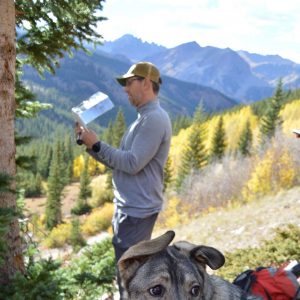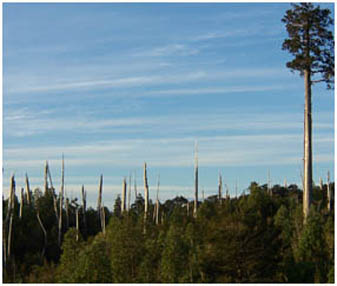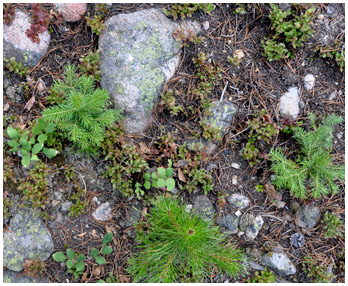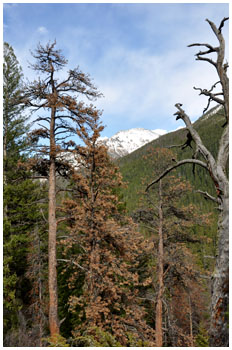More on Biogeography Lab
Jason S. Sibold
Assistant Professor of Geography
Department of Anthropology
Colorado State University
jason.sibold@colostate.edu
Office: (970) 491-4801
Faculty Member of the Graduate Degree
Program in Ecology
BA, MA, Ph D - University of Colorado

RESEARCH: Biogeography; disturbance ecology; fire history; human land use; climate variability and change; conservation; forest ecosystems of the American West and southern South America
CLASSES: Introduction to Geography, Climate Change: Ecosystem Implications, Spatial Analysis with Geographic Information Science, Cultural Geography, Mountain Geography
I am a geographer with research focused on elucidating the natural and anthropogenic drivers of forest ecosystem dynamics and change, with the goal of aiding forest ecosystem management, restoration and conservation. More specifically, I am interested in the influences of physical landscapes, biological characteristics, climate variability, and human land-use history on spatiotemporal patterns of fire and insect outbreaks and resulting forest landscape characteristics. My research is centered in the temperate forest ecosystems of the western U.S. and south-central Chile, and spans spatial scales from forest stands and landscapes to mountain ranges and regions, and temporal scales from interannual to multimillennial. In my research I use a combination of dendroecological (tree ring), Geographic Information System (GIS), and spatial analysis techniques. Current research projects include fire-insect interactions in the Colorado and Montana Rockies, fire history in the Great Basin, and fire history and regeneration in the Valdivian temperate rainforests of Chile.
PROSPECTIVE GRADUATE STUDENTS: Please look through the pages on this website to see if my research is of interest to you. I would also encourage you to explore the ANTHGR website. If my research and program are of interest, I encourage you to contact me via email to explore potential options for a graduate degree.
Biogeography Lab
The Biogeography Lab at Colorado State University is a 750 square foot facility in the General Services Building on the east side of campus. The space includes equipment for processing tree-ring samples, an area for meetings or seminars, and desk space and computers for graduate students.
Projects c. 2010?
FIRE HISTORY AND POST-FIRE REGENERATION OF ALERCE FORESTS, COAST RANGE, SOUTH-CENTRAL CHILE


Alerce (Fitzroya cupressoides), is an endangered, extremely long-lived (>3,500 years) conifer species endemic to the Coastal and Andes Ranges of south-central Chile. Alerce is a key species in the Valdivian temperate rainforest ecosystem, a biodiversity hotspot with a high number of endemic species. As a result of habitat loss and projected climate change in the region, the World Wildlife Fund designated the Valdivian temperate rainforest as one of the ten most threatened ecosystems worldwide. In addition to the impacts of more recent habitat loss, most extant stands of Alerce are in various stages of recovery following extensive EuroChilean settlement-era fires. The goal of this project is to investigate fire history in Alerce dominated stands to provide information on the fire regime, fire-climate relationships, and the relationships between fire history and the current regeneration status of Alerce. This work is being conducted in the Alerce Coastal Reserve and Valdivian Coastal Reserve in the Coastal Range of south-central Chile.
Collaborators: Mauro González and Antonio Lara (Universidad Austral de Chile)
Support: Fulbright Chile; FORECOS Institute, Universidad Austral de Chile; World Wildlife Fund; The Nature Conservancy
THE INFLUENCE OF DISTURBANCE AND MANAGEMENT HISTORY ON MOUNTAIN PINE BEETLE OUTBREAK SEVERITY AND STAND DEVELOPMENT, ROCKY MOUNTAIN NATIONAL PARK, COLORADO


Rocky Mountain National Park recently experienced a mountain pine beetle (MPB) outbreak of unprecedented scale and severity, the ecological legacies of which will influence the forest landscape for decades to centuries. Based on evidence from past bark beetle outbreaks it is clear that patterns of MPB outbreak severity and post-outbreak forest development are related to pre-outbreak stand characteristics, which are in turn associated with stand disturbance (e.g. fire, past MPB outbreaks) and management (e.g. thinning, prescribed fire) history. The goal of this research is to identify the role of disturbance and management histories in shaping patterns of outbreak severity and post-outbreak stand development trajectories in Rocky Mountain National Park.
Support: Rocky Mountain National Park, RM-CESU Grant, DOI.
FOREST DISTURBANCE ECOLOGY OF GLACIER NATIONAL PARK, MONTANA Glacier NP

Since the 1970s Glacier National Park has experienced many extensive high-severity ecological disturbance events including a mountain pine beetle outbreak and numerous fires. These events have dramatically reshaped the forest landscape of the park. Our current research in Glacier NP seeks to identify how interactions among land-use practices, climate variability and change, and disturbance characteristics (type, frequency and severity) shape patterns of disturbance spread and severity, and post-disturbance stand development.
Collaborator: Dennis Divoky, Fire Ecologist, Glacier National Park
Support: National Park Service, RM-CESU, DOI; Jerry O’Neal Fellowship, National Park Service (awarded to Ali Urza); The American Alpine Club Research Grant (awarded to Ali Urza).
REGENERATION DYNAMICS AND STATUS OF ISOLATED PONDEROSA PINE STANDS ON THE WESTERN SLOPE OF THE NORTHERN COLORADO FRONT RANGE


Ponderosa pine is a common species in the montane and upper montane forests of the eastern slope of the Northern Colorado Front Range but is extremely rare on the western slope of the range. The combination of the rarity of ponderosa pine on the western slope and the high severity of the recent mountain pine beetle outbreak in the region suggests that ponderosa is at risk of local extinction. The goal of this research project is to identify the relationship between ponderosa pine establishment and disturbance events including fires and insect outbreaks (mountain pine beetle and spruce budworm), and climate variability and survey the current status of the species on the west slope of the Northern Colorado Front Range.
Collaborator: Jenny Briggs, USGS, Lakewood, CO
Support: US Geological Survey; Rocky Mountain National Park, RM-CESU, DOI.
PRE-SETTLEMENT FIRE PATTERNS: RECORDS OF NATURAL FIRE OR ANTHROPOGENIC FIRE USE?
Ecosystem management goals of restoring or maintaining natural patterns of fire are dependent on the ability to identify natural fire regimes. However, the identification of natural fire regimes is predicated on the untested assumption that fire history reflects natural patterns of fire in contrast to Native American fire use. The goal of this project is to develop and test a methodology to identify Native American fire use influences on fire occurrence in the pre-EuroAmerican settlement era (ca. 1700-1860). Our study areas for this project include the Northern Colorado Front Range, Northwest Montana and the Andes of south-central Chile.
Collaborators: Mauro González (Universidad Austral de Chile), Laurie Huckaby (Rocky Mountain Research Station, USFS), Jason LaBelle (Colorado State University), Maria Nieves Zedeño (University of Arizona)
Support: Joint Fire Science Program
Publications
REFEREED JOURNAL ARTICLES:
Kilpatrick, M., F. Biondi, S. Strachan, and J.S. Sibold In Press. Fire history of a mixed conifer ecosystem in the south-eastern Great Basin, USA.
Urza, A.K., and J.S. Sibold. 2013. Assessing a non-destructive aging method for seedlings of four conifer species in northwestern Glacier National Park, Montana. Western Journal of Applied Forestry 28: 22-29.
Cheek, J.W., F. Biondi, J.S. Sibold, and R. Tausch. 2012. Fuel analysis and potential fire behavior in mixed conifer woodlands of the Great Basin, Nevada, USA. Physical Geography 33(3): 205–228.
Biondi, F., L.P. Jamieson, S. Strachan, J. Sibold, 2011. Dendroecological testing of the pyroclimatic hypothesis in the central Great Basin, Nevada, USA. Ecosphere 2:art5. [doi:10.1890/ES10-00068.1]
González, M.E., T.T. Veblen, and J.S Sibold,. 2010. Influence of fire severity on stand development of Araucaria araucana – Nothofagus pumilio stands in the Andean cordillera of south-central Chile, Austral Ecology, 35, 597-615.
Dilts, T.E., J.S. Sibold, and F. Biondi. 2009. A weights-of-evidence model for mapping the probability of fire occurrence in Lincoln County, Nevada, Annals of the Association of American Geographers, 99,
1-16.
Veblen, T.T.,T Kitzberger, E. Raffaele, M. Mermoz, M.E. González, J.S. Sibold, and A. Holz. 2008. The historical range of variability of fires in the Andean-Patagonian Nothofagus forest region, International Journal of Wildland Fire, 17, 724-741.
Sibold, J.S., T.T. Veblen, K. Chipko, L. Lawson, E. Mathis, and J. Scott. 2007. Influences of secondary disturbances of lodgepole pine stand development in Rocky Mountain National Park, Ecological Applications, 17, 1638–1655.
Sibold, J.S., and T.T. Veblen. 2006. Relationships of subalpine forest fires in the Colorado Front Range to interannual and multi-decadal scale climate variation. Journal of Biogeography, 33, 833-842.
Schumacher, S., B. Reineking, J.S. Sibold, and H. Bugmann. 2006. Modeling the impact of climate and vegetation on fire regimes in mountain landscapes. Landscape Ecology, 21, 539-554.
Sibold, J.S., T.T. Veblen, and M.E. González. 2006. Spatial and temporal variation in historic fire regimes in subalpine forests across the Colorado Front Range. Journal of Biogeography, 33, 631-647.
Schoennagel, T., T.T. Veblen, W.H. Romme, J.S. Sibold, and E.R. Cook. 2005. Annual (ENSO) and decadal (PDO) climate teleconnections affecting drought-induced fire occurrence in Rocky Mountain subalpine forests. Ecological Applications 15:2000-2014.
González, M.E., T.T. Veblen, and J.S. Sibold. 2005. Fire history of Araucaria-Nothofagus forests in Villarica National Park, Chile. Journal of Biogeography 32, 1187-1202.
Donnegan, J.A., T.T. Veblen and J.S. Sibold. 2001. Climatic and human influences on fire history in Pike National Forest, central Colorado, Can. J. of Forest Research 31, 1526-1539.
Sherriff, R.L., T.T. Veblen, and J.S. Sibold. 2001. Fire history in high elevation subalpine forests in the Colorado Front Range. Ecoscience 8, 369-380.
NON-REFEREED PROCEEDINGS/TRANSACTIONS:
Sibold, J.S. 2013. Testimony before the U.S. House Committee on Natural Resources. April 11, 2013.
(online: http://naturalresources.house.gov/uploadedfiles/siboldtestimony04-11-13.pdf)